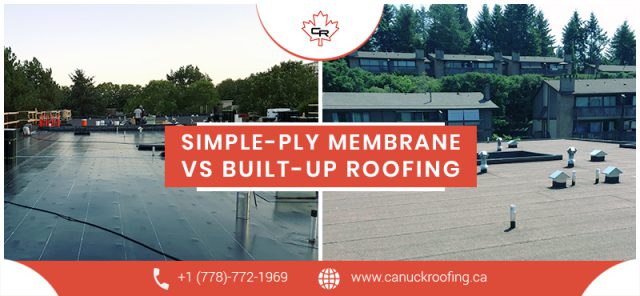The following article explores the differences between the single-ply membrane and built-up roofing systems to provide people all necessary information they need in choosing a roof for their facility.
INSTALLATION
Single-Ply Membrane Roofing
The initiation of the installation process is similar between EPDM and TPO single-ply membrane roofing systems.
After the existing substrate is prepared, either by removing or cleaning the existing roof, insulation is installed. There are a few kinds of insulation options that the facility manager/owner can choose from Extruded Polystyrene (XPS), Expanded Polystyrene(EPS), Polyisocyanurate (Polyiso). Insulation layers are cover boards. There are three ways to attach the membrane to cover board: ballasted, mechanically fastened or with an adhesive.
The basic difference between EPDM and TPO comes when it is time to adhere to membrane seams together. EPDM is joined together with seam tape. TPO uses a hot-air gun to meltdown the membrane at the seams and fuses them together.
Built-Up Roofing
The first layer can adhere directly to the roof substrate. If needed, a base sheet can be fastened to roof to create a flat and safe workspace. A built-up roofing system is installed by alternating layers of reinforced fabric and bitumen. Property managers can select three, four or five-ply roofs to meet their budgets and needs.
The last layer is rock or stone, this layer protects the underlying layers from extreme heat or cold, UV rays, and wind damage. A layer of gravel can be added to be more aesthetically appealing.
BASICS
Single-Ply Membrane Roofing
Single-Ply Membranes are sheets of synthetics and rubber that can be chemically adhered to ballasted or insulation creating a layer of protection on the commercial facility. There are two main kinds of single-ply membrane commercial roofing: EthylenePropylene Diene Terpolymer (EPDM) and Thermoplastic Polyolefin (TPO). They differ in their chemical makeup, how they are installed and energy efficiency.
Built-Up Roofing
For over 100 years, Built-Up Roofing Systems have been in use in the U.S. These roofs are commonly known as “tar and gravel” roofs. Built-up systems are installed by alternating plies of tar or asphalt and supporting fabrics directly onto the roof. People can choose the number of layers (or plies) that are installed. The final pile of a built-up roofing
the system consists of gravel or stone.
COST
Single-Ply Membrane Roofing
For a common 20,000 sq. foot commercial roof, it will normally cost between$3.50 to$6.50 per square foot for TPO and$3.50 to $7.50 per square foot for EPDM, including labor warranty and materials.
Built-Up Roofing
For a common commercial roof, it will generally cost between per $5.50 – $8.50 square foot in labor and materials to install a typical built-up roofing system. This cost range can change depending on the materials people choose.
ADVANTAGES
Single-Ply Membrane Roofing
A commercial single-ply membrane roof can last 30 years if properly installed and maintained. There are a few other advantages of single-ply membrane roofing systems:
- Proven Track Record– For over six decades, EPDM roofing has been used for commercial flat roofing. This time period on the market has allowed various field and laboratory studies to be performed and tracked.
- Class A Fire-Rated –EPDM and TPO membranes can obtain UnderwritersLaboratories (UL) Class A fire resistance listings by adding fire retardant chemicals during the manufacturing process.
- Reflective or Retentive –TPO is usually white and highly reflective. EPDM is often is known as “Black Roofs,” because of the natural dark color of the membrane.
Built-Up Roofing
A commercial built-up roof can last 40 years if properly installed and maintained. There are quite a few other advantages of built-up roofing systems:
- Seamless and Waterproof– Continuous solid surface does not need seams or joints, eliminating the most vulnerable area for leaking.
- Reflects UV Rays– offers ultra-violet protection.
- Low- maintenance– Minimal upkeep needed after installation.
DISADVANTAGES
Single-Ply Membrane Roofing
While the advantages of a single-ply membrane roofing system outweigh its disadvantages, there are a few things people should keep in mind. Here are disadvantages of single-ply membrane roofing systems:
- Seams –Although these seams are sealed either with melting adhesives or mechanically, they are still areas that are more vulnerable to leaks than other roofing systems.
- UV Rays –UV rays can degrade the adhesives quickly over time.
Built-Up Roofing
Built-up roofing systems have been around for decades; their longevity can only be obtained if the roof is maintained properly. Here are other disadvantages of built-up roofing systems:
- Time– Slower installation time frame
- Safety– Hazardous fumes and vapors when installing it
- Costs– Installation costs
- UV Rays– Without the gravel top layer, UV rays can break down the membrane quickly
Both Single-Ply Membrane and Built-Up Roofing Systems have their pros and cons. Selecting which one is best comes down to a customer-by-customer basis.

